From the living room window of her eleventh-floor apartment, Maria Morlin can peer directly into the large, wooden nests of Stanley Park’s great blue heron colony, which are scattered through the upper limbs of a grove of maple trees. For six months of each year she has a ringside seat for the courting antics of the birds, the building of their nests, the raising of their young and the chilling attacks by bald eagles.
For 20 consecutive years this colony’s herons have left these branches in late summer to disperse to various locations along the coast, then returned to lay and hatch their eggs at the onset of spring. It’s never a sure thing, though, that they will choose this place again for nesting.
This year in late February the herons did return to their Stanley Park roosts. Amidst the global pandemic that seems to have disrupted every human rhythm, Morlin finds new solace in watching them.
“The herons are flying around and interacting with one another like they always do. They’re completely indifferent as to our changed situation and yet I find their presence to be strangely comforting.”
Morlin didn’t choose the apartment because of its view (the herons first showed up a year after she moved in), but its location well suits her profession as a teacher of biology at Vancouver Community College. Her biological pursuits are wide-ranging. She has studied poison arrow frogs in Costa Rica, amphibians and reptiles in Bolivia, feral pigs in Australia, and flying squirrels in New Brunswick, but her heart is with the herons.
Her involvement with the colony has been a constant for two decades. Every two weeks during the nesting season she ascends to the roof of her building to count herons with members of the Stanley Park Ecology Society (SPES). Morlin has also included field studies of the herons in her classes at VCC and she recently spent three years filming a documentary about the herons entitled Flying Dinosaurs in the City that is available online.
Morlin has observed the returns of the herons long enough to note a certain order and consistency. “The first nest to be occupied is always the same one — B-2.” She gestures out her window as a great blue glides past like a feathered stealth bomber.
Morlin finds the herons intriguing for several reasons. “I think it’s fascinating that even though they are so large and ungainly, they still nest in trees. It’s also interesting that they live in such large colonies and that the males and females share responsibilities for nest building, incubating and parental care.”
Not everyone, in these stay at home times, might find living next to heronry so soothing. The birds come back each year ready to party, gathering like randy conventioneers to court and mate, and filling the air with their discordant, pterodactyl-like frak-frak-ing. The noisy throng can be observed from several vantage points on a popular heron cam that has recorded more than 200,000 views since its installation by the Vancouver Park Board in 2015. Last year, the herons occupied 82 nests and produced 112 fledglings.
That total makes it the third-largest colony in B.C., topped only by one located near Chilliwack and another in Tsawwassen with about 400 herons. The young produced at these sites are invaluable for replenishing struggling colonies in other parts of the west coast, where the great blues are classified as an at-risk species, having lost much of their nesting habitat in the lower Fraser Valley to human encroachment.
B.C.’s heron population constitutes a distinct subspecies that differ from the great blues in other parts of Canada in appearance (darker plumage and shorter legs), and because they do not migrate.
Some 80 per cent of B.C.’s estimated population of 5,000 herons live in and around the Fraser River Delta and the Strait of Georgia, in the same area that 80 per cent of British Columbians call home. With so many people and birds sharing the same space, it’s not surprising that it has become harder for this normally shy and reclusive species to find undisturbed nesting sites.
Undisturbed, however, does not describe the Stanley Park colony, which sits in one of Vancouver’s most densely populated areas, directly above a large complex of tennis courts, bordered on one side by a brewpub and on the other by the Park Board headquarters and a wall of high-rise apartments.
Not only must these herons contend with noise from car alarms and stereos, garbage trucks, lawnmowers and hedge trimmers, they are also subject to a sonic onslaught during events at English Bay and Ceperley Park, including blaring public-address systems, roaring crowds and exploding fireworks during the annual Celebration of Light Festival.
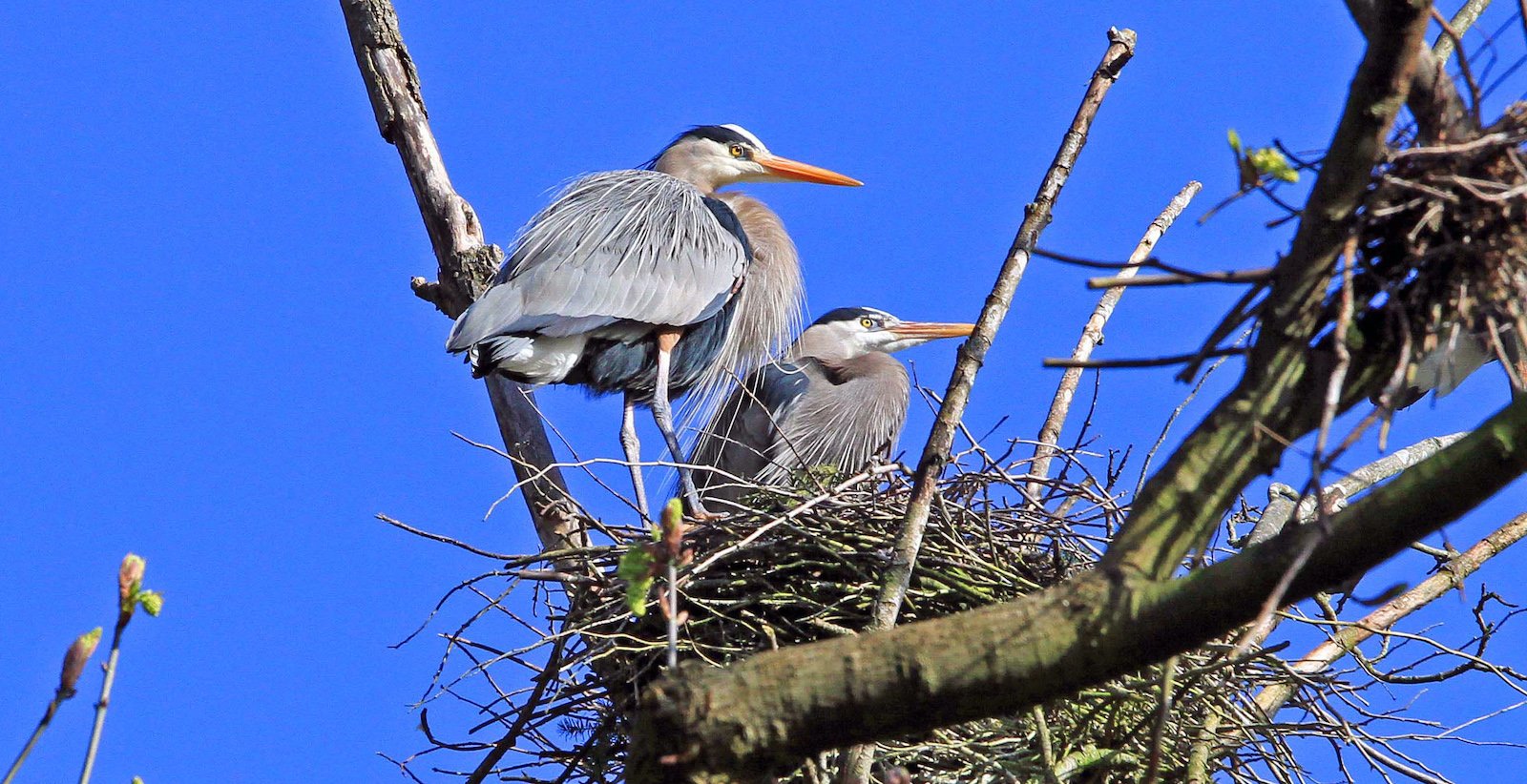
Ross Vennesland, a senior species at risk biologist for Environment and Climate Change Canada, who has been studying great blues since the 1990s, believes the Stanley Park colony is unique in the world and admits its citified existence is viewed by biologists as “a bit of a conundrum.”
There is undoubtedly a habituation factor at work as heron colonies have existed in the park at various locales dating back to at least 1921. The original site at Brockton Pont, remained until the 1960s when the birds moved to near the former zoo. In 1994, the zoo was closed, but the herons stayed and the population grew to 44 nests.
Then, in 2000, the heronry disappeared only to re-materialize at the present site in 2001. There were only six nests that first season, but the numbers grew rapidly, reaching a high of 176 nests in 2006, when the population was bolstered by refugees from a site in Pacific Spirit Park that was abandoned after repeated blitzes by bald eagles.
Bald eagles are the great blues’ main predator. In fact, the incredible revival of the eagles from the verge of extinction after the ban of DDT in 1972 has had a damaging impact on the west coast heron population. In 1999, Vennesland did a study that revealed that eagles targeting heron eggs or young were responsible for the abandonment of 12 of 31 heron colonies in the Strait of Georgia, Lower Mainland and on Vancouver Island.
However, recent investigations have revealed that the relationship between the two species has evolved. It’s now apparent that herons will deliberately establish colonies near a pair of nesting bald eagles in order to gain a measure of protection, as the highly territorial eagles will drive away any rivals that enter within a 250-metre range of their nest.
Vennesland likens this behaviour to store owners paying duty to a Mafia protection ring in order to avoid being extorted by other criminals. The herons accept losing some of their young to one pair of bald eagles in order to avoid the greater risk of exposing themselves to widespread attacks by owls, hawks and other eagles. “It’s a case of the devil you know being better than the devil you don’t,” says Vennesland.
This phenomenon first became apparent in 2004 when a massive colony of some 400 herons abandoned its nesting site just across the U.S. border in Point Roberts and followed a pair of bald eagles to a new location in Tsawwassen, eventually taking up residency near the tree inhabited by the eagles. In the Chilliwack colony some herons have even built nests in the same tree as a nesting pair of bald eagles.
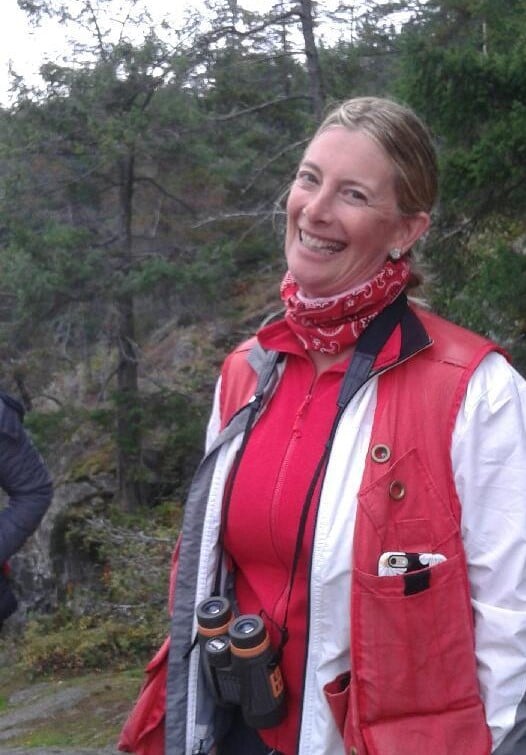
“We tend to think of these birds’ behaviours as being hardwired over time, but we are seeing a real adaption. The herons are demonstrating that they are very sophisticated beings capable of altering their behaviour to cope with changes in their environment,” explains biologist Rob Butler, president of the Pacific WildLife foundation and author of the 1997 book, The Great Blue Heron.
This deal with the devil becomes an even more favourable option when eagles have a rich supply of alternative food sources as in Tsawwassen. “The heronry may look a free lunch counter for the eagles, but the herons will fight back,” says Butler. “They will tug at the eagles tail feathers and peck at them. It’s much easier for an eagle to simply pick up a dead fish from the beach.”
Oddly, the Stanley Park site does not enjoy this type of territorial protection. The colony exists in a kind of no-man’s land, open to predation from at least four nearby nesting pairs of eagles. In some years the attrition rates are severe. In 2011, it is estimated that half of the colony’s failed nests fell prey to eagles.
“The eagles tend to come for the eggs early in the morning,” says Morlin. “I’ve seen them sitting there with the yolk dripping off their faces and steam rising out of their mouths.” In her documentary, Morlin tracked repeated eagle assaults on the B-2 nest. Despite this adversity the herons persisted after their first clutch of eggs were destroyed, producing another brood and eventually raising several young, only to have the eagles return to take them as well.
I personally witnessed an attack by an eagle last spring. It was a disturbing sight. As the invader zoomed in the entire colony took to the air and began circling above, unleashing an unholy din that reminded me of the soundtrack in horror movies when the earth opens up and all the devils from the underworld stream to the surface. The distressed parents stood on nearby branches, flailing their wings and shrieking, but the eagle ignored their protests, helping itself to the eggs in two nests before making his exit.
Morlin says that the herons’ response to eagle attacks changes throughout the year. Early in the season the entire colony flees, but once the chicks hatch, only the herons in the tree that holds the nest the eagle attacks take flight, and then after that only the herons in the nest that the eagle targets.
Although wildlife officials can’t do anything about the eagles, they have taken steps to protect the herons from other threats. The gates of the fenced area below the heronry are secured to reduce human disturbance while also protecting passersby from falling debris, and metal bands have been attached to the trees to prevent marauding raccoons from reaching the nests.
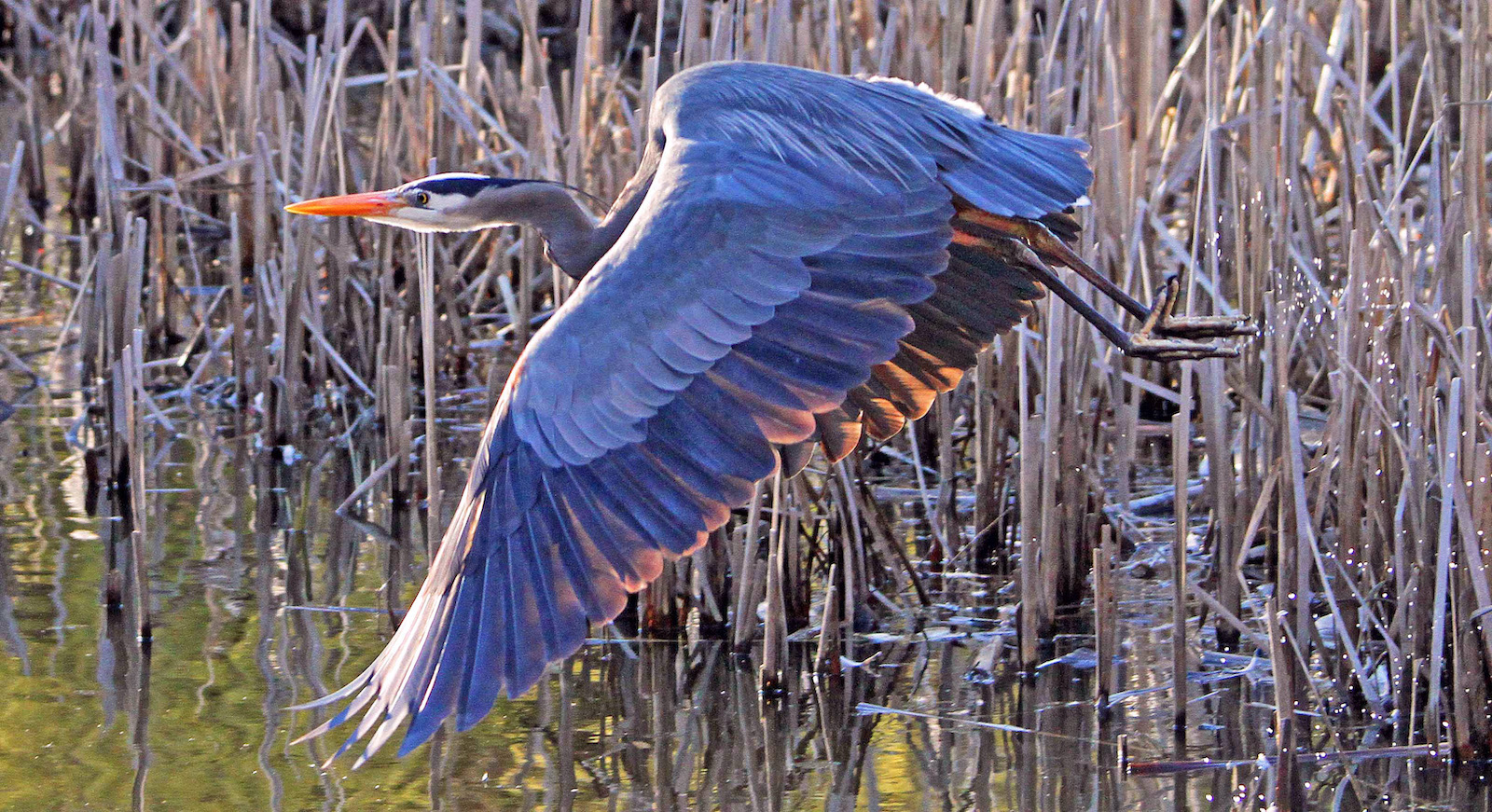
A monitoring program run by SPES and a crew of volunteers begins shortly after the herons arrive and undergo their annual personality transformation from solitary loners to party animals. The birds engage in elaborate courtship rituals in which males try to attract mates by fanning their long plumes, bobbing their necks and flouncing their wings. Bill clacking, neck stretching, crest raising and circular flights are performed until a pair bonds and copulates. Then they begin constructing or retrofitting an existing nest, with the male collecting twigs, bark and moss, and bringing them to the female, who weaves them into a solid platform able to resist strong winds.
Herons hatch an average of four eggs a season, but only about 30 per cent of chicks make it past the first year. If the food supply is scarce, only the strongest nestlings survive—the smaller ones end up falling from the nest, pushed out by their more dominant siblings.
Once the young are born, both parents forage for food, usually small fish, but also frogs, crabs, snakes, salamanders and mice. The females hunt during the day and the males at night. When the adults return to the nest, they regurgitate the food into the hatchlings’ mouths. The chicks grow at a superheated pace, attaining full size within two months, the equivalent of a human reaching adulthood in four years. Before fully fledging, they become “branchers,” venturing to nearby limbs where they flap their wings vigorously, building up strength for their first flight.
As the chicks mature, the noise level rises. To escape, some locals sublet their apartments and move elsewhere during the warmer months when windows are open and the colony is in full chatter. In addition to the sound there is also the guano which falls to the ground in splatters and coats the surrounding leaves in white.
When Vancouver filmmaker Mike McKinlay was shooting a film about the heronry in 2010, he posted signs requesting input from locals. “Every time I went to the park I found that my signs had been ripped apart,” recalls McKinlay.
“I was down there one day looking at one of my ripped signs when a little old lady came up and asked, ‘Are you the person making this film? You have to stop. These birds have ruined my life. I haven’t been able to sleep for months. I want them all to die.’”
Although that hostile attitude may still exist in some quarters, Dannie Piezas, urban wildlife programs coordinator at SPES, feels that most residents appreciate their presence. “There’s a real excitement around the herons and their annual return. It’s an iconic bird for the city. People feel privileged to have the colony there.”
Morlin says that it certainly applies to her neighbours. “People in this apartment building are really engaged. They get very excited when the herons come back. They run around sharing photos and stories about what they have seen.”
Eventually though the colony will depart for another location and when it does there will be a local sense of loss. Morlin may feel it more than others as the arrival of the herons’ signals spring for her and has become a backdrop for her daily life. Despite the drama and clamour the birds bring, she finds that they provide a valuable reminder that humans and wildlife can successfully co-exist in such close proximity.
The thought of the great blues leaving stirs a memory. “I remember one day after an eagle attack when the entire colony took flight. I was concerned, as always, that the herons were gone forever,” says Morlin.
“I raced up to the roof and began scanning the sky with my binoculars. I couldn’t see any birds, but then I heard a rustling sound. When I turned around there were four herons sitting on the railing of the elevator shaft staring down at me.”
When Morlin looks outside these days, she sees far fewer people wandering about in the park below, which is now cloaked in an eerie stillness. Public health precautions for COVID-19 have kept her more isolated and also more preoccupied, as she sets up the online program for her courses at VCC.
Still, it’s a comfort to know she has company. “My windows are on the same level as the tops of the trees, so it sometimes seems as though I am actually living with the herons.” ![]()
Read more: Environment


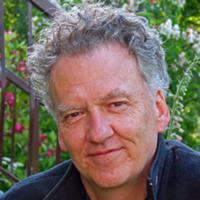
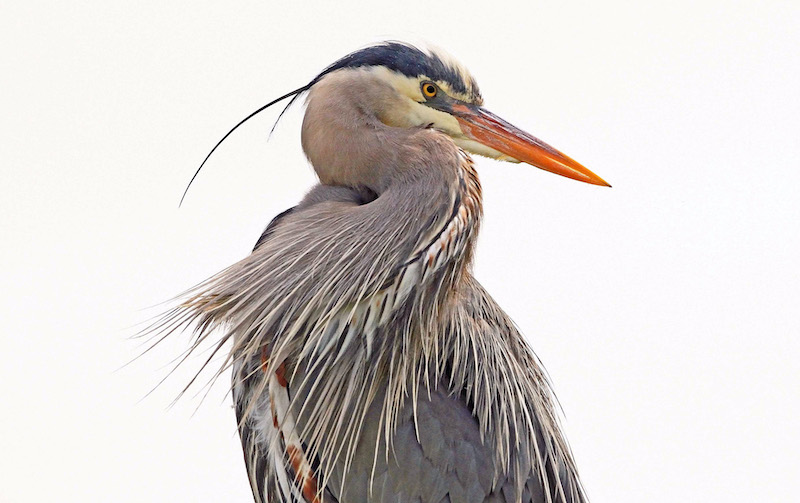












Tyee Commenting Guidelines
Comments that violate guidelines risk being deleted, and violations may result in a temporary or permanent user ban. Maintain the spirit of good conversation to stay in the discussion.
*Please note The Tyee is not a forum for spreading misinformation about COVID-19, denying its existence or minimizing its risk to public health.
Do:
Do not: